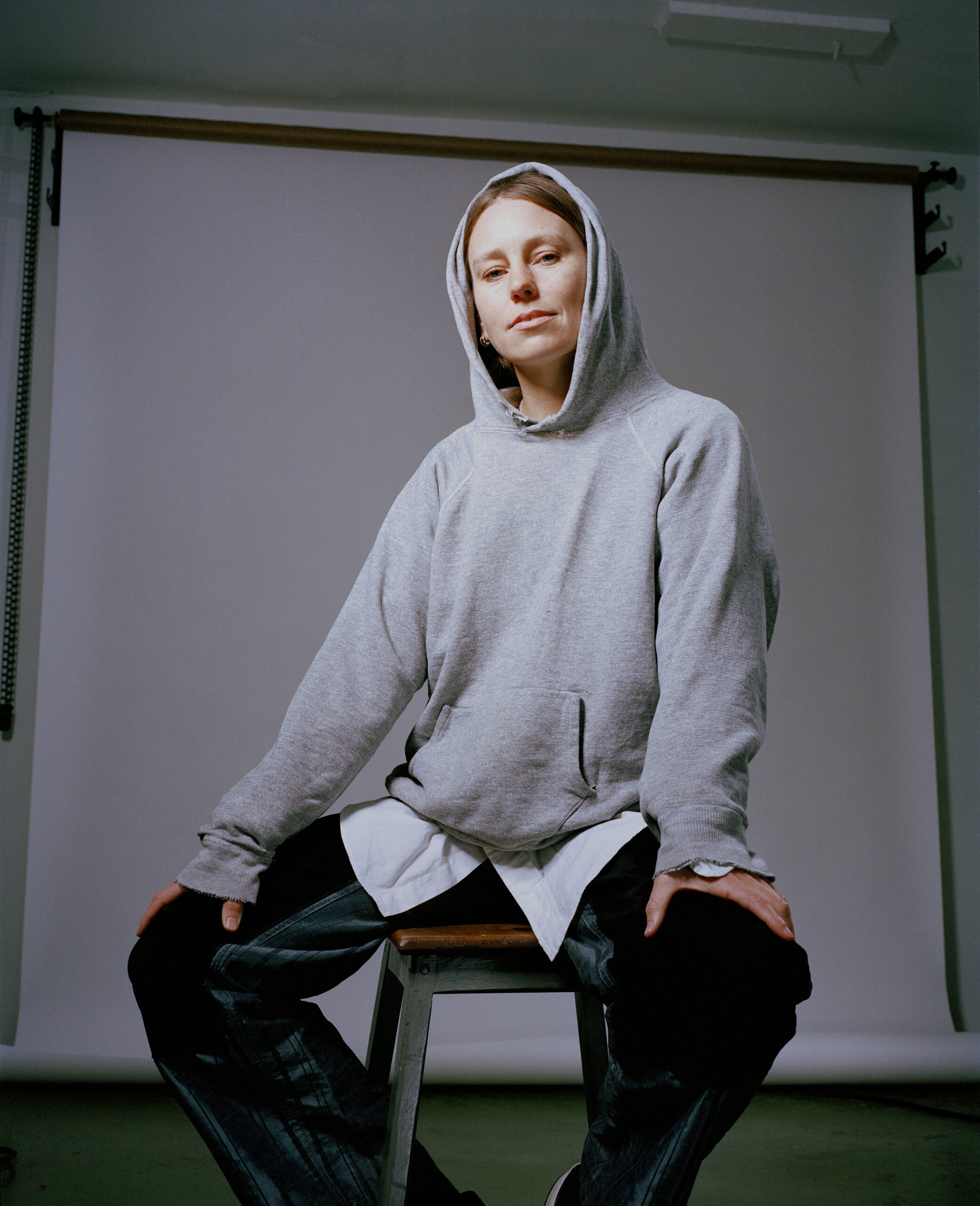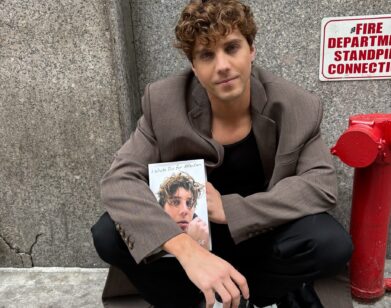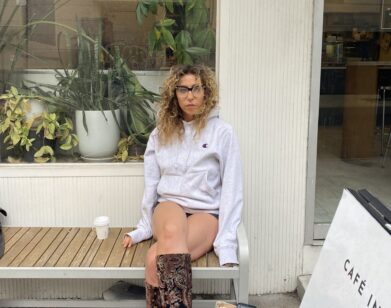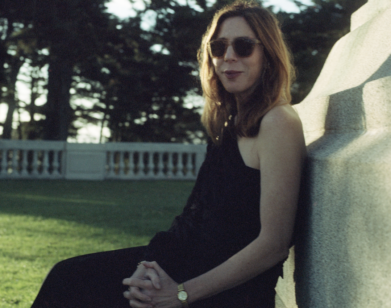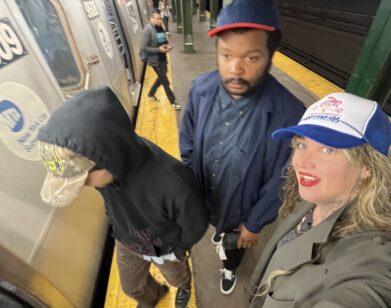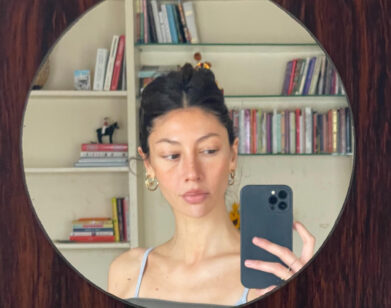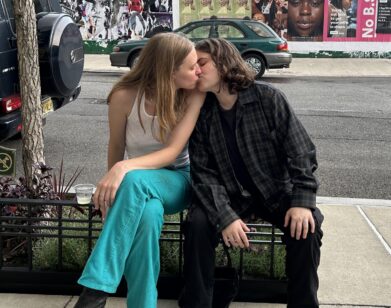IN CONVERSATION
Rosie Stockton and Rachel Kushner on Pump Jacks, Death Drives, and the Uses of Metaphor
Rosie Stockton’s latest book of poetry, Fuel, is imbued with the contradictions of the Los Angeles landscape, penned and edited, in part, in the labyrinthine lobby of the Bonaventure Hotel, where Stockton spent time as an Apogee Graphics resident. Fuel excavates the industrial heartland of the Central Valley, a place where pump jacks and blossoming almond trees exist in tandem. The collection, in which Stockton holds up personal heartbreak as a mirror to the tragedy of environmental decay, exemplifies the disparate elements that poetry can meld: land rights, oil fields, sex, biblical apocalypse, and climate disaster. “This book is a chronicle of endings,” Stockton explained to fellow Californian and acclaimed novelist Rachel Kushner when they got together last month at their favorite steakhouse-cum-jazz club. “Desire will always retain an element of dissatisfaction.” It is not difficult to discern parallels between Stockton’s poetics and Kushner’s work, particularly her most recent novel, Creation Lake. Both share an interest in “the world’s inner workings,” finding themselves drawn to the intersection of the real and libidinal economies that shape our existence. Over lunch, the writers delved into the provocative heart of Fuel, exploring its core elements: Lacanian psychoanalysis, fracking, and metaphors that aren’t “merely cute.”—JULIETTE JEFFERS
———
RACHEL KUSHNER: It’s Saturday, April 12th, full spring in Los Angeles. On my way here there was a riot of blooming poppies and desert willow in the little scraggly interim between the freeway exit and the now-abandoned former Macy’s department store. And now we’re at Colombo’s Italian Steakhouse & Jazz Club.
ROSIE STOCKTON: Yep, where we’ve been a lot, actually. It’s kind of our spot.
KUSHNER: Right. It’s a kind of traditional Sunday night meeting place of ours to feel a little fancy on the weekend, but we’ve never eaten lunch here together.
STOCKTON: No, never been here for lunch. Usually dinner.
KUSHNER: How do you feel about the bar area in the daytime, as opposed to the evening?
STOCKTON: Before you got here they weren’t playing the jazz yet. It was dead silence. And there was one very old man waiting for a take-out order, counting his money over and over.
KUSHNER: Cash.
STOCKTON: All cash. Spread out on that table across from us. And at the bar, they’re watching the Masters Tournament.
KUSHNER: What sport are we talking about?
STOCKTON: [Laughs] Golf. And the guy was yelling on his phone to someone in his family trying to get the score. And I was like, “You could just go around the corner to the bar to see the score.”
KUSHNER: Yesterday I went on an all-day field trip that felt like the perfect primer to reread your new book of poems, Fuel, which I did this morning. The trip was with filmmaker James Benning, who teaches a class at CalArts called “Looking and Listening.” We met in the parking lot at 8 AM and drove out past the town of Mojave and into the desert. Seven miles up a dirt road off Highway 14 is Burro Schmidt Tunnel. Are you familiar with it??
STOCKTON: No.
KUSHNER: In 1906, a German gold prospector began digging this tunnel through a mountain by hand and with dynamite. He worked on it for 20 years. It was never used as the intended railroad shortcut. The idea was for the students to walk through this pitch-black tunnel where you have to put your hands overhead and feel your way. But the road was washed out. Instead, we drove to the nearby salt flats and walked out on this baked dry lake.
STOCKTON: Well, good. I love when a failed mission takes you somewhere else unexpected.
KUSHNER: Which reminds me of your epigraph, by Bernadette Mayer, “Is my shoelessness mine?” If there is no lack, there is nothing to want. So then we drove to Tehachapi, visited the Tehachapi Loop, which is the busiest stretch of rail in America. We waited hours but saw no trains. Later, we drove to an overlook where you can view the entire valley. James noted this is where the Joad family in The Grapes of Wrath first glimpses California’s promise. It seemed fitting when considering your relationship to the Central Valley, industrial agriculture and the oil industry in Bakersfield. We bonded early on over an understanding that living in Los Angeles while simultaneously caring about the mechanics of the world, requires some love for what goes on in the Central Valley.
STOCKTON: Oh, absolutely. I could go on about my love for the Central Valley for a very long time. But I want to circle back to what you said about the double luck of the two failed missions and how, as you put it, if you get what you want, if your mission fully satiates you—
KUSHNER: Then you short-circuit desire.
STOCKTON: Right. I believe the highest act of love is to have a mutual understanding between two people that you can never fully give each other what you want. There’s always going to be a lack of satiation in desire. Love is being able to mutually acknowledge this. This is what I was working through in this book. To go back to the Bernadette Meyer quote, these are my shoes but is my shoelessness mine? Can I possess my own loss, what I long for? If I attain it, I’ll no longer yearn for it. Desire is a constantly receding horizon. I’ll never be the tunnel. I’m the train that never arrives. And so I love this story of what happened yesterday. As for the Central Valley, my best friend, Elizabeth, is from Bakersfield, and she took me to the spot where the kids drink beer, which overlooks a sea of oil fields, with pump jacks moving up and down. Beyond them, you can see ranchland. You can see almond orchards. Kern County is the biggest producer of oil in California and maybe in the nation as well, and it’s the fourth biggest producer of agriculture in the US, And so this idea of the riches of California, what the Joads saw, you really can stand on these overlooks and take in how much production is happening in the Central Valley. And it is so beautiful. And it is so horrifying. And Bakersfield is such a shitty city.
KUSHNER: Hold on, I love Bakersfield. It’s wonderful, except for the air quality.
STOCKTON: And the very high rate of police killings.
KUSHNER: True. Number one for that, according to the Guardian newspaper. But I still love it. Even the part you see off highway 65, with all the oil pipes, a Seussian landscape of plunder.
STOCKTON: Right, driving through “Oildale.” In a way, I might have a sort of teenage-boy perverse fixation on the pump jacks. They move so slowly, and you see goopy oil come up out of the ground. And it’s just disgusting. And part of me just can’t believe that this is how oil is extracted from the earth.
KUSHNER: “The pulse in the ground” is one of your lines.
STOCKTON: Which is the pulse of the pump jack. The pump jack mechanism doesn’t require much energy. The balance is making them go up and down, and then the oil flows through this indeed very Dr. Seussian series of pipes. If I could provide a visualization of the apocalypse, this is it.
KUSHNER: Like, the rhythm of a mechanical system continues even after all the life has been bled out of it.
STOCKTON: In my book I think I used the pump jack as both a metaphor and a metonym for extraction of different kinds, outside of just the oil industry. Also interpersonal extraction, extraction as part of how we have to move through the world. I have questions about the bottom, the limit, the end, and does debt have a bottom?
KUSHNER: You have a line about “sublimating the kitchen floor.”
STOCKTON: We are not just sweeping it. Any act is a symptom of something else, psychically, an expression of the unconscious in some way.
KUSHNER: Another line of yours: “Despair makes a hero out of me.”
STOCKTON: It’s a bit tongue-in-cheek, trying to make fun of my own cathexis to suffering. But I also think there’s something brave in not turning away from suffering. This book is a chronicle of endings. It’s the unraveling of a relationship. It’s a book of climate catastrophe. It strives to reckon with despair on multiple scales. How do we reconcile our intimate conflicts and alienation, our heartaches, with the Earth’s heartbreak and the heartbreak of the geopolitical devastation?
KUSHNER: You have this line in your acknowledgments, “The death drive is actually on the side of life.” We have to work from this supposition, to keep teasing out joy.
STOCKTON: Absolutely. The death drive is linked to repetition. It’s what sustains you. If the death drive ceases, you reach a stasis, which means the death drive has won? Absent that drive, that repetition, we can’t live.
KUSHNER: The death drive is in the driver’s seat. Your book addresses multiple kinds of incredible, cataclysmic loss.
STOCKTON: Exactly. There’s a sequence of poems in here that are love letters to the End.
KUSHNER: I wanted to ask you about those.
STOCKTON: As I was composing these love letters to the End, it dawned on me: “I’m writing these letters not to my beloved, but to the End, which is a sort of master signifier of all relationships. The specter of loss, of catastrophe, of abandonment.
KUSHNER: Is the End, then, a personified form of address?
STOCKTON: For sure.
KUSHNER: Is the “subject supposed to know” a cruel, Old Testament god?
STOCKTON: Right, no matter who I am addressing, the anxiety beneath the address is, “What’s going to happen in the end? How will my heart break? How will the collective heart break? And how is that such a powerful fantasy?” Freud says something like: “Every fear contains a wish.” I was really trying to lean into that, being like, “Oh, here are all the things I am afraid of in my interpersonal relationships. In what ways might I actually, paradoxically, desire them?”
KUSHNER: A wish is just a—
STOCKTON: A prayer?
KUSHNER: A violently sublimated desire.
STOCKTON: As I wrote these love letters, I was contemplating various scales and discourses around endings, from romantic love, to climate catastrophe and the end of the inhabitable earth and biblical notions of apocalypse, like in the Book of Revelation. The etymology of apocalypse is to reveal.
KUSHNER: As you say in the book.
STOCKTON: I really do think poetry has this special capacity to be an apocalyptic form, in service to revelation. It can put such discreet things in proximity, like an oil field and sex, climate catastrophe and heartbreak. I was thinking of apocalyptic discourses, biblical framings of the end times. I also thinking of Aimé Césaire’s decolonial poetics, where he says something like, “The only thing worth beginning is the end of the world.” That is, world as a metaphysical concept that organizes common sense, and is very violent. The only thing we can hope for is to end the world as we know it. The book grapples with the fear of the apocalypse, the fear of endings. But also asks how do we make space for a new relation, a new world, a new livable fantasy.
KUSHNER: Here’s a question that renders some of what you’re exploring more base and vulgar. I sometimes think we’re just all waiting for “breaking news” to finally disrupt everything. As if the end, when the systems crumble and everything must be rebooted, is in actuality a kind of beginning, because everyone can stop waiting for the end.
STOCKTON: I’ve thought about that too. We are obsessed with the disaster right around the corner. In these love letters to the end, the end is ghosting me. It’s like I’m refreshing the screen, hoping to see the very thing I fear, seeking breaking news.
KUSHNER: You write for Parapraxis, you’re very involved in psychoanalysis in your graduate studies at UCLA. It seems to deeply inform these poems. But also as another type of metaphor, where the language of psychoanalysis is just giving us another set of tools to comprehend non-human forms, and also the earth as we have constructed it. Like, is our death drive out there in the oil fields?
STOCKTON: Yes, I love that reading. And yes, these poems are really influenced by psychoanalytic theory, particularly Lacanian theory. I’m obsessed with the impossibility of getting what you want. The structure of desire being such that if you do get what you want, then desire stops. So actually, desire needs the subject to not satiate itself.
KUSHNER: That’s what we call the libidinal economy, as opposed to…
STOCKTON: The political economy. Psychoanalysis has been very useful for me both in thinking about what’s at stake interpersonally and politically in terms of, like, the rampage of desire. Fuel, I think, is just another word for drive, for what motivates us, our “object-cause,” the gas in the tank that makes our desire go.
KUSHNER: Have you yourself been in Lacanian psychoanalysis?
STOCKTON: Yeah I am right now, for about five years now. Psychoanalysis has helped me understand that you cannot blame your love objects who will always disappoint you. They can never fill the void. They can never fix the wound of being in language, being alive. The least you could do is thank them, for allowing you to continue to desire, rather than admonish them for not giving you what you want.
KUSHNER: Because it’s better to want than to have. Love’s true object is absence. I thought Denis de Rougemont wrote that, but when I looked it up, I found only myself quoting it. His book Love in the Western World seems to explore the psychology of love in a way that Lacan maybe echoes, but I’m not remotely an expert on Lacan. Instead, I was merely a patient.
STOCKTON: I have a friend who was like, “Isn’t Lacan illegal for queer people, given all the politically problematic aspects of contemporary Lacanianism? I believe Parapraxis Magazine, for instance, is really trying to think about how to–
KUSHNER: Make Lacan great again?
STOCKTON: I didn’t say that. Hannah Zeavin is going to be like, “No…”
KUSHNER: I was joking.
STOCKTON: Hilarious. Anyhow, how to make psychoanalysis useful for leftist politics. I think people are trying to grapple with a lot of different tendencies of psychoanalysis and I’m particularly interested in Lacan. About love’s true object being absence: I came across a meme that said something like, “If he writes you one sonnet, he’s in love with you. But if he writes you a hundred sonnets, he just likes writing sonnets.” Which I think is just another way of saying this. “Oh, this is merely about his own experience of desire, not love for the person,” like Petrarch’s sonnets about Laura. He just liked writing sonnets.
KUSHNER: The language of finance capital flashes up here and there in the poems.
STOCKTON: Working in the form of lyric love poetry and then bringing in the diction of finance capital, I was trying to put these micro and macro scales together, to reveal something about how our lives are structured. I’m interested in the possibilities and failures of metaphor. Fuel is not just a metaphor. The symbol has to become equally incoherent or break down. I really appreciate the notion that whatever something is being compared to must be affected by the comparison as much as it affects the comparison.
KUSHNER: Let’s take groundwater and the body, since that’s a compelling example in the book.
STOCKTON: So groundwater is something beneath the surface. We don’t see it. The infrastructure is built to deliver water to people. So then, what can comparing groundwater to the body’s mechanisms do to both understand something about the water that is literally traveling from the ground into the body, that is—
KUSHNER: Water that possesses its own flux and flow.
STOCKTON: Yeah, I mean, that’s beautiful. So then, how do our bodies, and society, in turn impact the groundwater? How are these relationships mutually influencing one another in ways that are both life-giving and also profoundly extractive and terrifying? We reside in Southern California. For how much longer will there be water?
KUSHNER: I was just going to say, there’s so much we take for granted about the unconscious and also about the Earth. Regarding oil in the context of fuel, you referenced the title of this book you read, The Story of Oil. I looked it up but couldn’t find a copy. Where did you come across it?
STOCKTON: It’s public domain. It was probably published in the early 19th century, when petroleum was becoming more globalized.
KUSHNER: That guy had also written a book about whaling, which is intriguing, because oil replaced whale oil.
STOCKTON: Yes, I love that fact. It disturbs me. When I selected the title Fuel, I was actually thinking a lot about Moby Dick, a gay classic…
KUSHNER: Because whale oil was fuel.
STOCKTON: Exactly. There’s a poem in Fuel that literally just takes lines from The Story of Oil and interweaves them with my own. The form really mimics the mechanics of a pump jack actually—the up and down, up and down. Something about the Central Valley that is true for all agricultural land is that the farmers will own the top soil, the oil companies will own, on the same plot, what’s below, and then maybe it’s the city or the county or whoever that owns the water. You’ll literally see almond orchards with pump jacks beside the trees, each extracting from different depths of the same land. Different entities have competing claims to what appears as a single piece of land.
KUSHNER: This makes me think of California prisons, because our largest women’s prison, CCWF, is sited amidst almond orchards. You teach poetry at the other women’s prison, CIW.
STOCKTON: That’s right.
KUSHNER: Are you in one of those trailers? That’s where I did my reading when I was there. My feeling of CIW was that it was more chaotic and less nightmarishly controlled and sterile, like CCWF.
STOCKTON: Yes, exactly. I also taught at a women’s prison in Michigan that was way more high security than CIW.
KUSHNER: That’s when you were living in Detroit. There’s an interesting reference in the poems to Detroit, “neon class war.”
STOCKTON: Yes. Eight Mile, when I was driving home from work one day, and there’s just bar after bar, club after club.
KUSHNER: You’re from New Mexico, which is an interesting part of all this. There’s a reference to half-life in the poem. I thought this is the residue of somebody who grew up where atomic nuclear experimentation took place. You’re from Los Alamos, right?
STOCKTON: Yes, an infamous town.
KUSHNER: But then as a poet, there’s a little Detroit, and obviously California, in the book. It’s only occurring to me now that there’s an interesting Philip Levine resonance there. Are you interested in his poems?
STOCKTON: He’s from Detroit?
KUSHNER: He’s from Detroit.
STOCKTON: Right, of course. He has that poem about Belle Isle.
KUSHNER: He worked in the automobile factories. Then he came out and taught at Fresno State for his entire career.
STOCKTON: I didn’t know that.
KUSHNER: Yeah. There are poets from Fresno who, I think, became poets because Philip Levine was there and they went to Fresno State.
STOCKTON: People don’t talk about the Fresno School.
KUSHNER: Well, we are.
STOCKTON: Let’s platform the Fresno School. Anyway—yes, I’m from Los Alamos, the atomic town. There are huge political battles about how and where nuclear waste is buried in the earth, because it never decomposes. To calculate how far into the earth the nuclear waste must be buried, they have to model the potential rates of erosion, which depends on climate change, weather patterns for decades, hundreds of years. These materials don’t break down. Nuclear waste is there forever.
KUSHNER: I’ve read about these markers and them trying to figure out what language to put them in so future people would be able to read, “Don’t dig here.” Is that something you thought about growing up in Los Alamos?
STOCKTON: You really can’t not. I was very politicized in high school and disturbed by the idea of nuclear weapons just on principle—seems bad, right? As I got older, thinking about the larger global political context of nuclear weapons, and nuclear waste became more available to me, those thoughts made their way into some of these poems. The whole town was built overnight in the 1930s to make the nuclear bomb, and the industry of the town to this day is the National Lab. Everyone’s seen Oppenheimer. A bunch of the extras were friends from high school.
KUSHNER: Oh, really?
STOCKTON: They filmed a scene in the building where we had high school prom.
KUSHNER: No way.
STOCKTON: Yeah.
KUSHNER: One thing about that film is it was so fucking loud. I couldn’t understand what anyone was saying because it had this turbulent soundscape underneath. Switching subjects, I wanted to ask about the poems in Emergency. Did you use a William Burroughs cut-up method?
STOCKTON: Oh, interesting. No, I did not. The poems in Emergency really allow the line to spill across the page rather than using line breaks consistently. I was thinking a lot about the cut, the function of the cut. Where do you cut a line? Which is to say, where does enjambment happen, and why?
KUSHNER: All writing is a variable length session.
STOCKTON: Mic drop. End scene. So when I was writing these lyric poems, my tendency is to be really indulgent with my line breaks. It’s a guilty pleasure of mine. I use enjambment really stubbornly. I had a line in the book that I took out that said, “I enjamb when I’m feeling needy.” It’s kind of a plea. I use enjambment more than punctuation in order to say two things at once.
KUSHNER: You make reference to a goldfinch slamming into a window. I just wanted to tell you, weird coincidence, but the day I finished my novel The Mars Room, I wrote the last line and then heard this really loud slam from downstairs. I was like, “Did someone just hit our window?” I went downstairs and there was a dead goldfinch on the welcome mat of my house.
STOCKTON: Wow, so sad.
KUSHNER: It was so beautiful, with its just-right-then expired vitality. And I thought, “The same thing happened to Rosie.” Not that it was the day you finished your book.
STOCKTON: I mean, yes, I was in bed and I heard it slam on my window, and I went outside and, just like you, saw this lifeless goldfinch.
KUSHNER: You have this wonderful line, “As if animals could make mistakes.” There’s something arrogant about the idea that it’s uniquely human to err. So anyway, I wanted to ask you about that.
STOCKTON: Well, yes, I’m like, “Shouldn’t goldfinches know that there is a window there?” I think maybe the difference between my goldfinch and yours is that when I found mine I kept it in the freezer for months. I was only able to bury it once I finished Fuel. I have a history of putting dead birds in the freezer.
KUSHNER: I kept my placenta in the freezer for several years because I was waiting to do something with it. At the time, I was a vegetarian, so I wasn’t really interested in eating it.
STOCKTON: You can’t eat your own placenta if you’re vegetarian?
KUSHNER: Yeah. I think if you’re not down with meat, viscerally, it’s a no—
STOCKTON: That’s cannibalism, I guess.
KUSHNER: We finally put it at the base of a grapefruit tree when we planted it. So with other birds that have flown into windows, your instinct is to preserve?
STOCKTON: For better or worse, yes. I keep them in a freezer until I find the perfect time to mourn them, which I think is a very bad habit, actually. There’s no perfect time to mourn anything. Mourning is always happening. I think when burying the goldfinch, I realized, there is no ceremony that actually can hold an ending.
KUSHNER: Death is like that. You just have to learn to live with it.
STOCKTON: Exactly.
KUSHNER: I wanted to mention that we got the idea to do this conversation right when you had just finished the manuscript. You finished it as a poet-in-residence at Apogee Graphics, whose offices are in the Bonaventure Hotel, made famous by Fredric Jameson and his theories of postmodernism, specifically postmodern architecture.
STOCKTON: Yes, I feel so lucky for that a month-long residency at Apogee Graphics, where I edited and finished the book.
KUSHNER: Apogee, I might say, is run by the artists Asha Schecter and Laura Owens, with Krum Wright as the studio manager there. Tell me about loving the Bonaventure. And for people who’ve never been there, there’s no natural light.
STOCKTON: I fell in love with the Bonaventure. It’s essentially designed so you get lost. And you must enjoy the frustration of getting lost at the Bonaventure. I tell people, “If you don’t get lost, you’re doing it wrong.” If you’re not enjoying how insane this architecture is, how are you getting through life? Now I run a reading series there with Chloe Watlington called “LA Prime.”
KUSHNER: Named after the restaurant on the top floor, where we got a free meal after I got stuck in the elevator.
STOCKTON: And it was a glass elevator, so I could see you. And all of the staff, trying to pry the doors open, even as it was between floors.
KUSHNER: Say more about making art there.
STOCKTON: On the fifth floor, there’s all these booths that look really similar to the booths at Colombo’s, actually, where it’s mostly high school students making out. But I could usually claim a booth and just curl up and write. I was in heaven. I was just so into surrendering to the sadism of that building and the failed utopianism of it. I would move into the Bonaventure. I think I could live there.
KUSHNER: There’s flow and porosity, the way those little artificial streams go through the lobby. So did any of that make its way into the poems themselves?
STOCKTON: The manuscript was pretty much done. But what I did do at the Bonaventure was edit out all of the titles of the poems. Each poem used to all have individual titles and I decided to take them out and replace them with brackets. It felt risky, letting the poems stand on their own and blur together in the sections, but I think it was the right call.
KUSHNER: You have a line, “There will be three of everything.” Is that about the father, the son, and the Holy Ghost?
STOCKTON: Oh my god, amazing, but no. I love this read. I was actually thinking about carbonless copy paper, when you sign a form and the ink transfers—
KUSHNER: In triplicate.
STOCKTON: Yeah, and then the indentation goes through to the forms below it. So that’s where that specific image comes from. But I do think that the structure of the triangle is very operative in desire. So, “there will be three of everything” is a nod to the Holy Trinity and also the triangle in Sappho, the famous poem where she can only feel desire when her lover is desiring someone else.
KUSHNER: You also have a line that goes, “Pour one out for the nervous system.” And I was thinking, is it a reference to what the rappers called tipping? A beautiful practice.
STOCKTON: The point of that line, for me, is that everyone’s always talking about the soul, your “soulmates,” et cetera. But we need to be talking about the nervous system. Love wrecks the nervous system. The way that our early childhood attachment wounds come out in our relationship are expressed in such profound limbic nervous system trauma that I—
KUSHNER: Oh, I see. So it’s a kind of memorial for the nervous system.
STOCKTON: Oh, yeah. My nervous system has been wrecked by love. So I’m like, “Pour one out.” Bless your heart, nervous system. We’ve gone through a lot together. The nervous system, evolutionarily, is probably older than the soul, metaphysically. This is my wager.
KUSHNER: Adam is mentioned in the book. I was like, “Adam who?” Of Eve?
STOCKTON: Well, of course Adam of Eve. Actually, Adam was a fracker with whom I had a personal interaction at one point. And then I was like, “But of course—Adam of Eve.”
KUSHNER: Tell us how you met him.
STOCKTON: That story is redacted, unfortunately.
KUSHNER: You’re redacting it right now.
STOCKTON: I’m redacting. But what I can say is that I spent hours with him while he told me about what it was like to work in the oil fields in Oklahoma and shared his theories about climate change and about how the oil industry might be stopped, which he didn’t believe was possible. And my interaction with Adam the fracker was another big well of language that I extracted from to put into the poems, my fracker muse.
KUSHNER: The original fracker who comes to stand for all the other frackers. And for all men. And his name was actually Adam. While you were not Eve, and you are not Eve.
STOCKTON: But I should have been.

